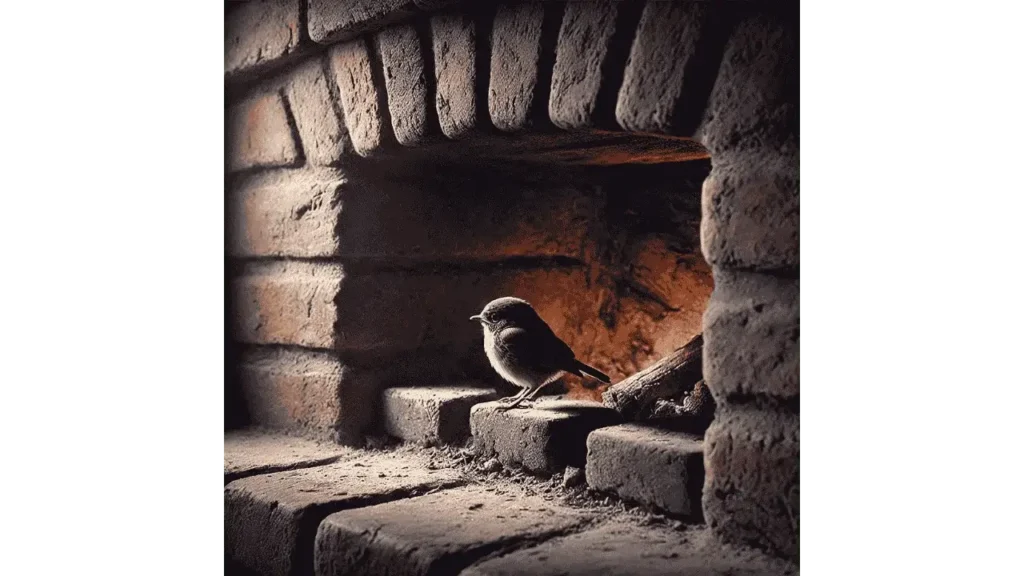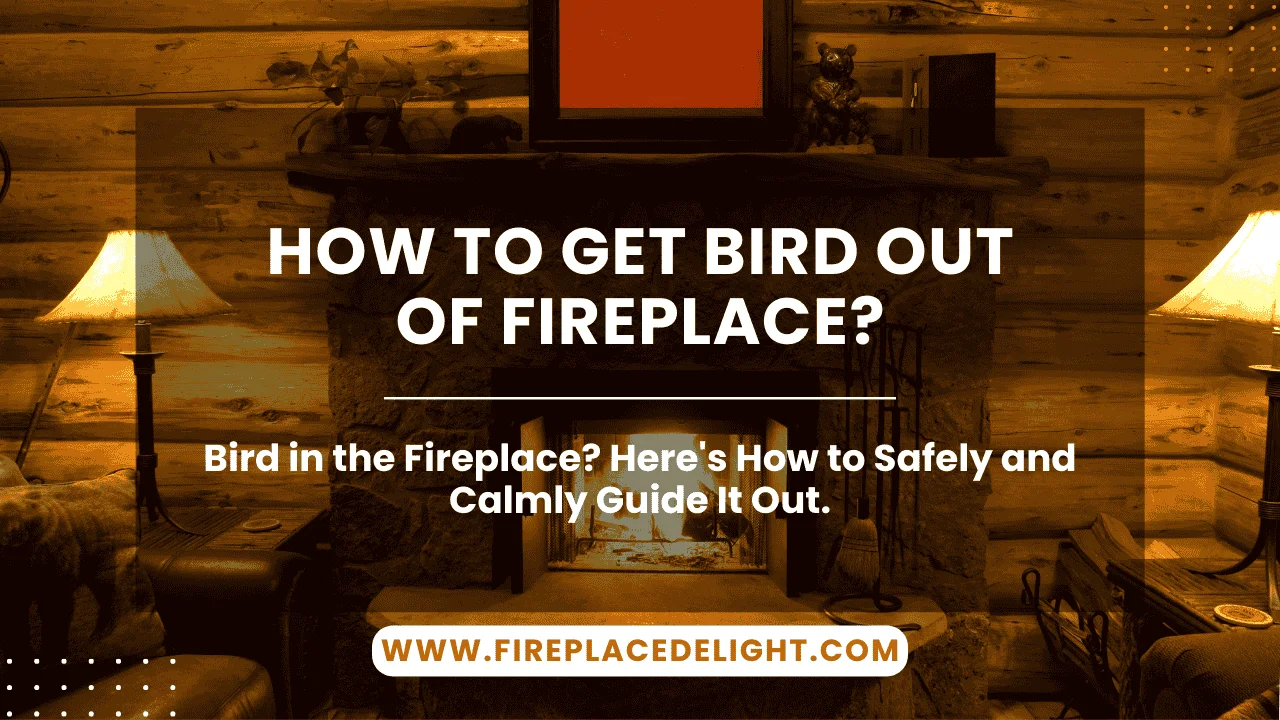Finding a bird trapped in your fireplace or chimney can be a startling experience, but it’s important to remain calm and act swiftly to help the bird safely find its way out. Birds often enter chimneys or fireplaces in search of warmth, shelter, or food, but once inside, they can easily become disoriented and unable to escape. Addressing the situation requires a gentle approach to avoid causing further distress to the bird or damage to your home.
In this guide, we’ll walk you through the steps you can take to safely remove a bird from your fireplace or chimney, as well as tips for preventing future incidents. With patience and the right techniques, you can ensure a safe and smooth escape for the bird and restore peace to your home.

How To Get A Bird Out Of A Fireplace Or Chimney?
When a bird becomes trapped in your fireplace or chimney, it can be a stressful situation for both you and the bird. Birds may enter your fireplace or chimney looking for shelter, warmth, or food, and may become disoriented once inside. It’s important to approach the situation calmly and safely to avoid injuring the bird or causing unnecessary distress. Here’s a step-by-step guide on how to safely remove a bird from your fireplace or chimney.
1. Stay Calm and Assess the Situation
The first step is to stay calm. Panicking will only make the situation more stressful for both you and the bird. Take a moment to assess the situation. Look inside the fireplace or chimney to determine the bird’s location. If the bird is stuck on a ledge or in the chimney, make sure you can access it safely without causing harm to the bird or yourself. Avoid rushing into the situation, as sudden movements could startle the bird or make it harder to catch.
2. Open the Damper
If your fireplace has a damper, opening it is often the best first step. The damper is the metal flap inside the chimney that regulates airflow, and opening it will give the bird a potential route to escape. Birds may naturally fly upward, and if the damper is open, they can move toward the opening of the chimney and fly out. However, if the bird is already trapped within the fireplace itself, opening the damper will allow it more freedom of movement and help it find its way out.
3. Create an Escape Route
If opening the damper doesn’t seem to help, or the bird isn’t responding to it, you may need to create a clearer path for the bird to exit. Open windows or doors in the room where the fireplace is located to provide a clear escape route. Birds are naturally attracted to open spaces and will likely attempt to fly toward the open window or door if it sees the light. If possible, dim the lights in the room and keep the area quiet to encourage the bird to fly in the direction of the open escape route.
Read More: What Is an Inglenook Fireplace?
4. Minimize Disturbance
Minimizing noise and movement around the fireplace is crucial to keeping the bird calm. Sudden movements or loud noises can frighten the bird and make it more difficult to guide it out. If there are other people or pets in the house, keep them away from the area where the bird is trapped. If you can, try to create a quiet environment so the bird feels safe enough to fly out on its own. Patience is key here, as the bird may take some time to calm down and realize it has an exit.
5. Use Food as Bait
If the bird is still not making its way out and you need to coax it, food can be an effective way to attract the bird toward the exit. Place a small dish of birdseed or a piece of fruit (such as an apple or a berry) near the exit point, whether it’s by the open door, window, or fireplace opening. The scent of food may encourage the bird to move toward it. Make sure the food is easy for the bird to see and access without causing it to feel cornered. As the bird approaches the food, it might naturally fly toward the open exit. Be patient, as it may take some time for the bird to find the food and feel comfortable enough to fly out of the house.
6. Use a Towel or Blanket
If the bird is still within the fireplace or chimney and isn’t responding to the open damper or escape route, you can try using a towel or blanket to gently encourage the bird toward the exit. Carefully and slowly approach the bird with the towel or blanket in hand. Place it over the bird to temporarily cover it and prevent it from flying further into the chimney or causing more distress. Once the bird is covered, you can carefully guide it toward the exit point, whether it’s an open door, window, or fireplace opening. The towel or blanket will help keep the bird calm and prevent further harm. Be sure to handle the bird with care, and allow it time to orient itself before encouraging it to fly out.
Learn More: How To Block Cold Air From Fireplace?
7. Seek Professional Help
If the bird continues to be stuck or the situation becomes too overwhelming, it’s a good idea to seek professional help. Wildlife rescue organizations, pest control specialists, or chimney professionals have the expertise and proper tools to safely remove the bird without causing harm. These professionals can also assess whether there are any additional issues, such as the bird being trapped too high in the chimney or a nest that needs to be removed. Seeking professional assistance ensures that both you and the bird remain safe throughout the process.
8. Prevent Future Incidents
Once the bird is safely removed, it’s important to take steps to prevent future incidents. Birds are often attracted to fireplaces and chimneys due to the warmth or shelter they provide, so it’s essential to make sure your fireplace is properly sealed when not in use. Regularly check for gaps or openings where birds could enter. In addition, keeping the chimney clean and well-maintained will discourage birds from nesting inside.
9. Install a Chimney Cap
A chimney cap is one of the most effective ways to prevent birds (and other animals) from entering your chimney in the future. Chimney caps cover the top of the chimney and allow smoke and gases to escape while keeping out debris, animals, and birds. It’s especially important if your chimney is open and accessible to wildlife. Installing a chimney cap can also improve the efficiency of your fireplace by preventing drafts and water from entering the chimney. It’s a relatively low-cost, simple solution that can save you from future headaches and potential hazards.
By using these additional methods, you can ensure that your home remains bird-free and safe from chimney-related issues, while also preventing similar problems in the future. Proper handling, quick action, and preventive measures will make sure that both you and the birds stay safe.
Conclusion
Getting a bird out of your fireplace or chimney may seem like a daunting task, but by staying calm and following the right steps, you can help the bird find its way out safely without causing harm. Opening the damper, creating an escape route, and using gentle methods like food or a towel can guide the bird toward freedom. If the situation proves difficult, don’t hesitate to seek professional help to ensure the bird is safely removed. Additionally, taking preventive measures such as installing a chimney cap and properly sealing the fireplace when not in use can help avoid future incidents. With these strategies, you can protect both your home and the wildlife, ensuring your fireplace remains a safe and welcoming space for you, not an unintended home for birds.
- How to Build an Electric Fireplace Wall? - June 4, 2025
- How to Clean an Electric Fireplace? - June 3, 2025
- How to Fix an Electric Fireplace? - June 2, 2025

